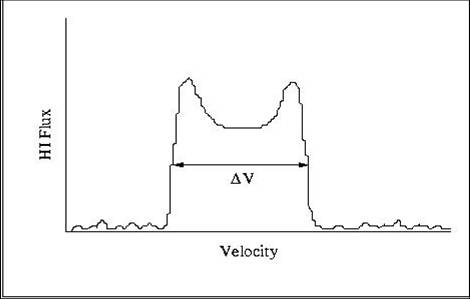ALFALFA detects the HI spectral profile of a galaxy, that is, its
HI line flux over the frequency range which corresponds to the radial velocities
of all the HI atoms in the galaxy. Hence, one of the principal ALFALFA data
products is the set of global HI profiles (HI flux versus velocity),
available through the Cornell
ALFALFA data archive.
We use the global HI profiles for each ALFALFA detection to yield three
parameters of scientific use:
- The midpoint of the emission profile in km/s, which yields the
systemic velocity of the galaxy as a whole. This in turn can be used
to make a estimate of the redshift-distance using
Hubble's law.
- The total HI line flux, integrated over the signal, ∫F dV, in Jy-km/s, which
can be used to derive the total
HI mass, using the estimated distance.
- The observed width of the HI line profile, in km/s, which gives the
observed Doppler broadening due principally to the galaxy's rotation.
In combination with an estimate of the galaxy's size and inclination on
the plane of the sky, the width parameter can be used to make an estimate
of the galaxy's total dynamical mass.
|

Sketch showing typical appearance of galaxy HI line profile.

Actual ALFALFA spectrum of UGC 7849. See the original available at the Cornell ALFALFA archive
|



